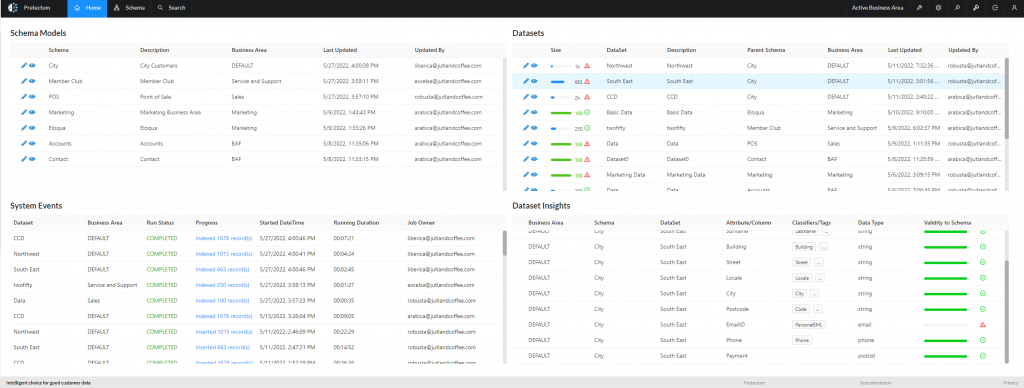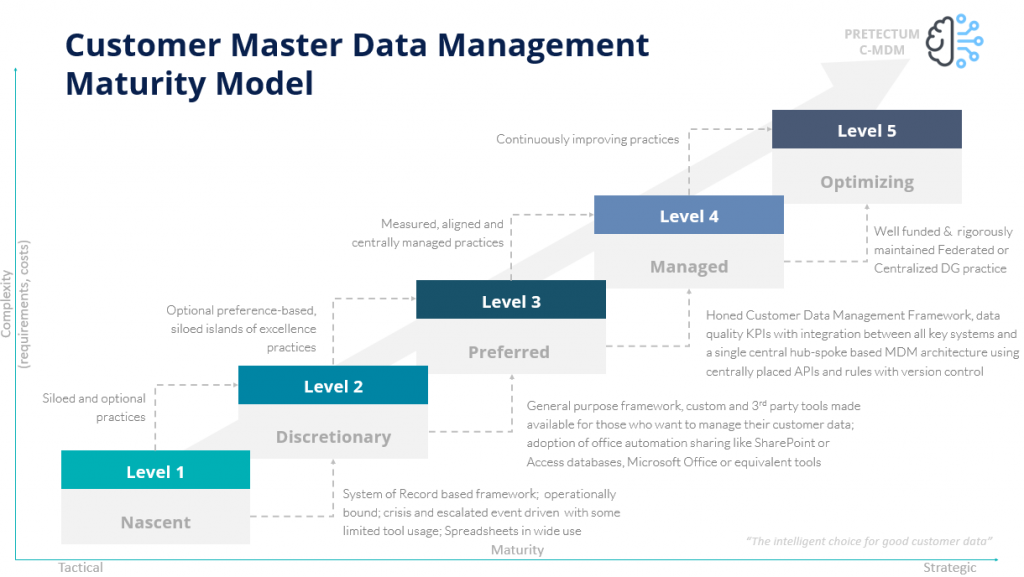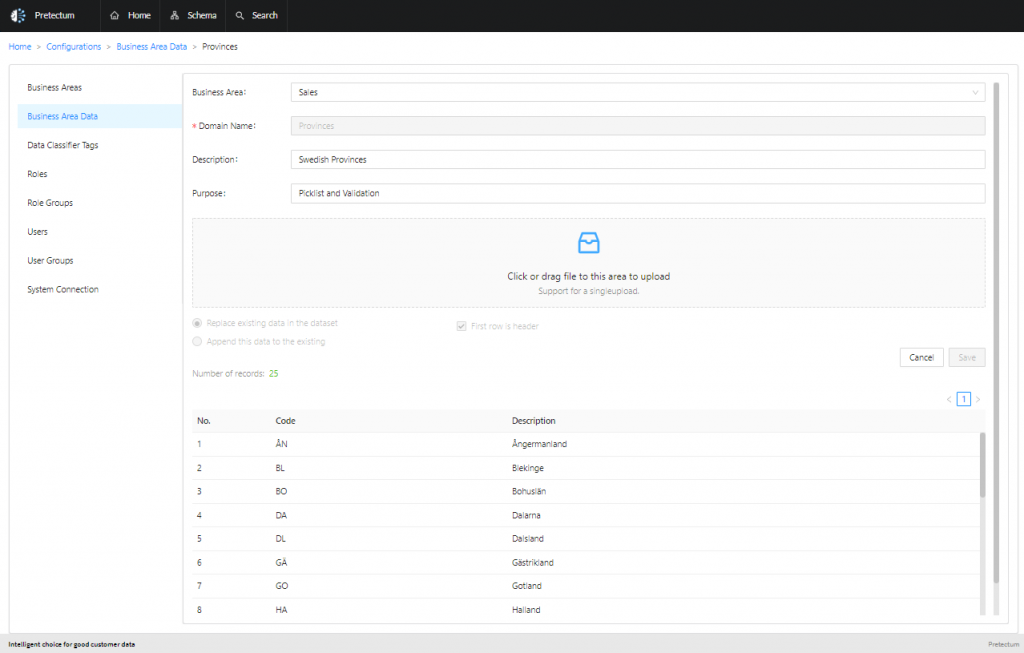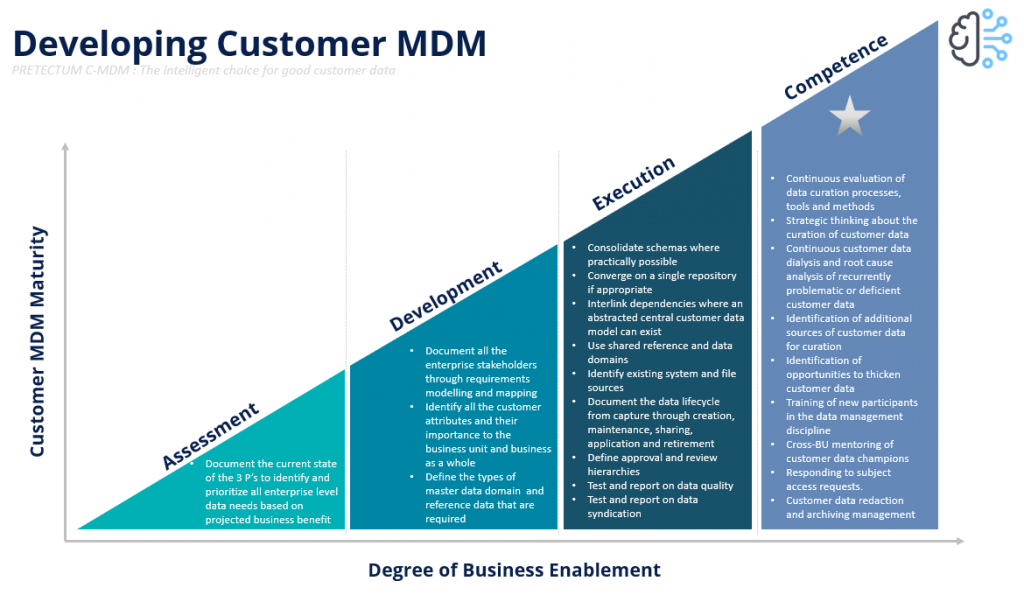A robust Customer Master Data Management environment, like that offered by the Pretectum Customer MDM solution, ensures a single, accurate, and complete view of customers across all systems. This foundation enables better decision-making, improved customer experiences, and operational efficiency.
To enhance your Customer Information strategy with Pretectum you will want to consider the enhancements to data quality and accuracy as a key factor.
Enhance Data Quality and Accuracy
A robust Customer data practice is one that ensures a single, accurate, and complete view of customers across all systems, enabling better decision-making, improved customer experiences, and operational efficiency. To enhance your customer data strategy, follow these key steps:
Assessing Data Maturity & Defining KPIs
Before diving headlong into trying to improve data quality, you would want to evaluate your current data maturity level through a data or data quality audit. While Pretectum doesn’t perform the audit itself, its flexible platform helps you address gaps identified in:

- Data Quality (accuracy, completeness, consistency): Pretectum’s ability to define one or more data models with strong data typing and data validations helps ensure data quality from the point of ingestion.
- Governance (policies, ownership, compliance): The platform’s configurable data tagging functionality (which doubles as a business glossary) and PII masking features directly support governance policies.
- Accessibility (integration, real-time availability): Pretectum facilitates data ingestion from diverse sources (CSV, JDBC, REST APIs, subscribed streams) and offers AI-powered elastic search for efficient data retrieval.
Customer data quality KPIs to measure data quality program success.
Customer data quality KPIs would be key performance indicators that you would use to measure the success of a data quality program in ensuring the accuracy, completeness, and reliability of customer data.

These KPIs help many organizations to track and monitor the effectiveness of their data quality efforts and identify areas for improvement. Some common customer data quality KPIs align with the DAMA measures and include:
Data accuracy (% of error-free records): This KPI measures the extent to which customer data is free from errors, inconsistencies, and inaccuracies. It can be measured by tracking the percentage of data records that are accurate and up-to-date.
Data completeness (% of records with mandatory completeness): This KPI assesses the extent to which customer data is complete and contains all the necessary information. It can be measured by tracking the percentage of data fields that are populated and not missing any key information.
Data consistency (% of records with matching value correctness): This KPI measures the level of consistency in customer data across different systems, channels, and touchpoints. It can be measured by tracking the percentage of data records that are consistent and aligned with each other.
Data reliability (% of duplicate entries): This KPI evaluates the reliability and trustworthiness of customer data in terms of its source, validity, and relevance. It can be measured by tracking the percentage of data records that are reliable and credible and not duplicative.
Data timeliness (speed of data-driven decisions): This KPI assesses the timeliness of customer data in terms of how quickly it is updated, refreshed, and made available for use. It can be measured by tracking the percentage of data records that are timely and up-to-date (Time-to-Insight).
By defining and tracking these customer data quality KPIs, your organization can effectively measure the success of their data quality program and ensure that their customer data is accurate, complete, reliable, consistent, and timely.
Strengthen Data Governance
Pretectum’s robust features directly support a strong data governance framework, ensuring consistency and reliability. Key actions you get to benefit from range from Defining Data Standards – by implementing strong data typing and data validations directly within Pretectum’s data models (schemas) through Data Stewardship Assignments by way of Pretectum’s sophisticated and configurable permissions matrix (RBAC) allows for precise role assignment, including view-only access and PII unmasking permissions, ensuring accountability.
You are also able to Implement Validation Rules via data models can be enhanced with strong data typing and data validations. During manual entry, bad data is blocked. For batch ingests, data is flagged as matching validation or not. Business area data can also be used as part of the schema attribute validation sets and ensure Regulatory Compliance for PII data is automatically masked, and revealing it requires re-authentication, which is logged in an audit log, aiding compliance.

Improve Data Quality Through Cleansing & Enrichment
Pretectum provides powerful capabilities for data cleansing and supports the integration of enriched data.
Data Cleansing fundamentals
- Remove duplicates via a A batch-based process allows users to run a duplicate matching process across one or more business areas and datasets. This creates matchsets, enabling a second batch process to merge or purge records to a nominated survivor based on configurable survivorship rules.
- Standardize ingested data formats via lightweight ETL processes can be applied during ingestion, using Excel-like syntax to transform data at the attribute level, helping standardize formats.
- Validate against trusted sources – your data can be validated against business area data, which can include ISO codes or other reference data.
Data Enrichment
- Enhance records with external data: While Pretectum focuses on ingesting data based on defined schemas, its flexibility means you can incorporate enriched data (e.g., demographic data) if it’s drawn in from diverse sources.
- Leverage AI/ML for predictive analytics: AI prompts can be used to create focused tags, accelerating the creation of a business glossary that can be used for context building in AI-powered elastic search.

Establish Ongoing Monitoring & Maintenance
Pretectum facilitates continuous data quality and accuracy through its monitoring and maintenance features. Automated Data Quality Checks: mean that manual record entry is validated in real-time, blocking bad data. For batch ingests, data is accepted and flagged for validation matching. Regular Audit controls are supported when all PII unmasking and self-service data validation/consent granting events are recorded in an audit log. Feedback Loops that are customer-centric are supported via self-service data validation and consent granting process allows targets in the record to edit, redact, and self-consent their data, providing a direct feedback mechanism, and Continuous Improvement is achieved because the platform’s flexible nature allows schemas and datasets to be edited, appended to, or replaced according to evolving business needs.
Wrapping it up with a bow
Elevating customer data management with Pretectum requires just a few steps of dligence:
- Assessing data maturity & setting KPIs
- Implementing strong data governance with Pretectum’s built-in controls
- Cleansing & enriching customer data using its transformation and matching capabilities
- Monitoring & maintaining data quality through its validation, audit, and self-service features
Leveraging Pretectum’s structured approach any business can reduce errors, enhance decision-making, and drive customer-centric strategies with reliable and accurate master data, all while benefiting from its AI-powered search and intelligent data retrieval.
For your business here are some next steps to consider:
- Conduct a data maturity assessment to identify specific areas where Pretectum can be best leveraged.
- Define clear data governance policies, aligning them with Pretectum’s PII masking, validation, and RBAC features.
- Utilize Pretectum’s automated data quality tools, including its lightweight ETL and duplicate matching processes – contact us to learn more!
- Train teams on data stewardship best practices, emphasizing the use of Pretectum’s data tagging and self-service validation functionalities.


